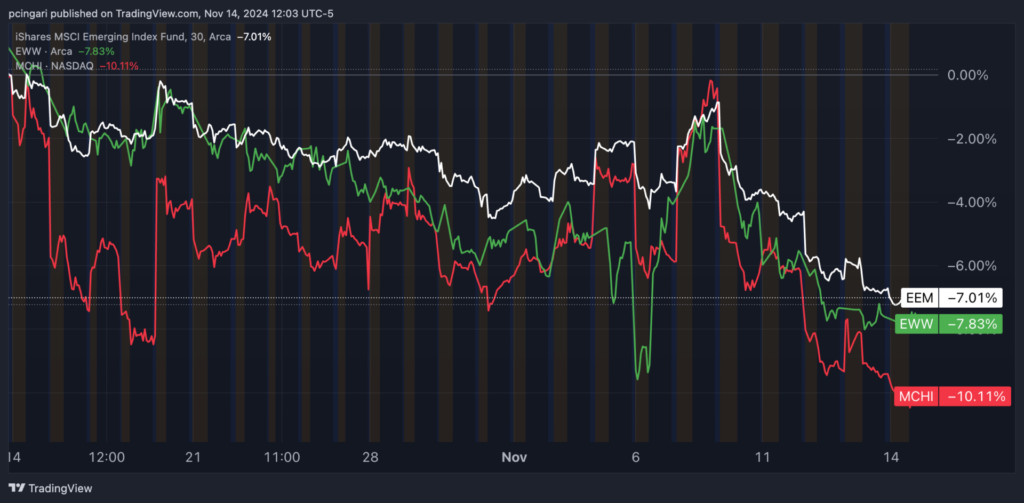Zinger Key Points
- Trump’s win and Republican control spark fears of U.S. protectionism, potentially impacting trade-dependent emerging markets.
- Rising U.S. interest rates increase borrowing costs for EMs, pressuring debt-heavy economies reliant on cheap credit.
- Get real-time earnings alerts before the market moves and access expert analysis that uncovers hidden opportunities in the post-earnings chaos.
Emerging market stocks have dropped to levels last seen in mid-September, with the downturn exacerbated by Donald Trump's victory and a Republican sweep of the U.S. Congress.
The iShares MSCI Emerging Markets ETF EEM has slumped 7% over the past month, with the iShares MSCI China ETF MCHI and the iShares Mexico ETF EWW underperforming — down 10.1% and 7.8%, respectively.
Trump’s win and full Republican control of Washington, D.C. raise critical questions for emerging markets (EM). What does a more protectionist U.S. policy and potential fiscal loosening mean for emerging economies, currencies and credit conditions?
Why Are Emerging Markets Falling?
Trump's election has sparked concerns over possible shifts in U.S. fiscal and trade policies that could have a ripple effect on global markets.
“The prospects of looser fiscal policy and more trade protectionism have increased short- and long-term U.S. interest rates, putting upward pressure on borrowing costs in EMs,” according to Elijah Oliveros-Rosen, chief emerging markets economist at S&P Global Ratings.
Higher U.S. interest rates tend to strengthen the dollar, making it more expensive for emerging markets to service dollar-denominated debt. This tighter financial environment has already started affecting emerging market currencies, which have weakened across the board against the dollar.

EM Currency Depreciation: A Major Concern
Following Trump's win, most EM currencies — especially in Central and Eastern Europe and Latin America — have depreciated significantly against the U.S. dollar.
Investors worry the Federal Reserve may delay rate cuts in response to Trump’s policies, which could include new tariffs or stricter immigration rules. A stronger dollar and potential trade barriers pose serious risks for EM economies reliant on exports and foreign investment.
The Mexican peso, in particular, has been hit hard by Trump's election, as uncertainty over trade and immigration policies toward Mexico has made investors skittish.
Private fixed investment in Mexico, which has been strong over the last two years due to nearshoring, could lose momentum until there's more clarity on U.S. policy.
“During the Trump 2016-2020 administration (excluding the pandemic), private fixed investment in Mexico declined 4.5%,” S&P Global wrote in a report.
Tightening Financial Conditions For EM
The rise in U.S. interest rates is tightening financial conditions for EMs, which rely heavily on affordable credit to finance growth.
With borrowing costs rising, fiscal vulnerabilities in these markets could become more pronounced, potentially limiting governments' ability to stimulate their economies.
"Volatility in emerging market assets is expected to remain elevated for some time due to uncertainties surrounding U.S. policy details including trade, fiscal, and regulatory environment," said Oliveros-Rosen.
Investors are likely to remain on edge until the new administration clarifies its approach, particularly toward trade.
Impact On Credit Ratings, Market Activity
The tightening financial environment is already impacting EM credit ratings.
While the number of issuers rated ‘CCC+' and below has decreased slightly, indicating some deleveraging, many EM companies are still struggling with high debt levels. Riskier credits have been able to refinance for the first time since November 2021, but this could come at the cost of reduced capital expenditures in 2025-2026.
Corporate bond spreads in EMs remain tight, supporting robust market activity for speculative-grade issuers. With two months left in 2024, all EM regions — except for Asia — have already surpassed their average bond issuance volumes from the last seven years. Both benchmark and corporate yields have edged up amid the uncertainty, reflecting a more cautious investor sentiment.
Long-Term Outlook: Headwinds, Opportunities
Looking ahead, EMs face a mixed outlook. In the near term, "volatility in emerging market assets is expected to remain elevated for some time due to uncertainties surrounding U.S. policy details including, trade, fiscal, and regulatory environment,” S&P Global wrote.
Yet, demographics, technology, and the global energy transition could provide structural growth tailwinds over the next decade, potentially offsetting some of the risks posed by a protectionist U.S. stance.
Supply-chain shifts and nearshoring trends, particularly in regions like Latin America, may also help some EMs attract investment.
As Oliveros-Rosen stated, "The specific policies announced by the next U.S. administration could either further amplify or reverse the recent tightening in financial conditions, with implications for EM growth and credit conditions."
In other words, the ball is in Washington's court. Whether EMs face a full-blown crisis or simply a period of adjustment will depend largely on Trump's policy choices in 2025.
Read Next:
Photo: Shutterstock
© 2025 Benzinga.com. Benzinga does not provide investment advice. All rights reserved.
Trade confidently with insights and alerts from analyst ratings, free reports and breaking news that affects the stocks you care about.